|
The Society
Historical Information
Photo & Map Collections
Exploring Brookline
Links
Program Archives
|
Mamie Williams 1882 Gem Tintype Album
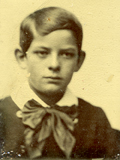 |
Stephen Perkins Cabot, 1882 [identity speculative]
1869-1951; never married; Parents: Francis Cabot, Mary Louisa Higginson; lived on Heath Street at the corner of Boylston Street.
His father was a wealthy cotton manufacturer. Stephen graduated from Harvard. He was in the class of 1892 but because of ill health did not receive his degree until 1901, spending much of the intervening time in Europe. He had a long teaching career, most of it at St. Georgeís School in Newport, Rhode Island. He began teaching there in 1901 and was headmaster from 1917 until his retirement in 1926. He later became involved in social work, heading various organizations including the Judge Baker Guidance Center, the Greater Boston Community Fund, and the Family Welfare Society.
We cannot completely rule out that the first initial reads as an F which would favor the identification instead as older brothers Frederick or Follen.
|
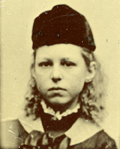 |
Louise Harding Williams, 1882
1869 Ė 1902; never married; parents: Thomas Blake Williams, Alice Harding Weld; born in West Roxbury on the Brookline border, lived in Boston.
She and Mamie Williams, the owner of the album, were first cousins once removed. (Her father and Mamieís paternal grandfather were brothers.) She was also a first cousin of Bernard, Richard, and A. Winsor Weld, also in this album. (Their fathers and Louiseís mother were siblings.) Her father worked in the family wine and liquor importing business, J.D. & M. Williams. He died in June 1878 when he escaped from attendees at the McLean Asylum, where he had been confined for several months, and drowned himself in Mystic Lake. Louise traveled with her aunt and uncle and other Bostonians across Canada and to Alaska by train in 1892. In 1893, she graduated from the Boston Cooking School. She worked with many charitable organizations including the Perkins Institution and Massachusetts Association for the Blind. She was especially active at Lincoln House in the South End of Boston, part of the settlement movement providing services to the poor. She was an assistant to Ellen H. Richards, the first woman to be admitted to MIT and a pioneer in nutrition and home economics, in the publication in 1902 of The Dietary Computer, a booklet promoting good nutrition for settlement workers and housewives. Louise died in Cohasset August 1902 at the age of 33. A tribute from the Perkins School said "She died from over-exertion in seeking to solve scientifically the great problem of how to feed the poor well and at the same time with economy. Literally she gave herself, with all the enthusiasm of her young heart, to the well-being of the indigent and the needy."
|
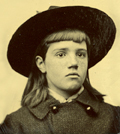 |
Sally Fairchild, 1882
1869 - 1960; never married; parents: Charles Fairchild, Elizabeth "Lilly" Nelson; lived in Boston Her sister, Lucia, is also featured in this album. Her father was a wealthy stock broker and banker and her parents were frequent hosts of prominent artists and writers. She never married and often lived with her younger brother, Gordon: at St Paulís School where he ran the Upper School; in the Philippines; in Japan; and, when he returned to Boston around 1930, at his house at 391 Beacon St., Boston. After he died at sea in 1932 she moved to 241 Beacon St.
She made quite an impression on some very famous people of that era. There are descriptions of her by George Bernard Shaw, Bertrand Russell, George Santayana, the Fabian leader Beatrice Webb, and the Shakespearean actress Ellen Terry. Shaw took several photographs of her and corresponded with her for many years. She also gave a young Ethel Barrymore a letter of introduction to Shaw. Here is a description from Gertrude Kittredge Eaton, in her Reminiscences Of St. Paul's School: "Mrs. Fairchild had at one time what might be called a salon, in Boston. She knew all the interesting people of the day. She was one of the first to appreciate Walt Whitman. John Singer Sargent was a great friend, and painted many pictures of Sally, who had lovely red hair. Red hair fascinated Sargent. She was an early admirer of Robert Louis Stevenson. When her husband went abroad one year, she told him to look up young Stevenson and have Sargent paint his portrait, which he did. Stevenson stayed with the Fairchilds in Boston, and Gordon remembered sitting on the foot of his bed while Stevenson told him stories. There are many letters to the Fairchilds in the collected letters of Stevenson. "
|
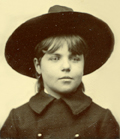 |
Lucia Fairchild, 1882
1872 - 1924; married, 1893, Henry Brown Fuller; parents: Charles Fairchild, Elizabeth "Lilly" Nelson; lived in Boston
Her sister, Sally, is also featured in this album. Her father was a wealthy stock broker and banker and her parents were frequent hosts of prominent artists and writers. She married at a young age a fellow student at Cowles Art School that she attended. She became a well-known painter and won a number of international art competitions. At the age of only 23 she was commissioned to paint a mural for the Woman's Building at the 1893 World's Columbian Exposition in Chicago. Her work is held by the Metropolitan Museum of Art and other major museums.. The young couple moved to Deerfield, MA, the home town of her husband, where they had two children. In 1897 they began a residence at the Cornish Art Colony in Plainfield, New Hampshire. Her husband, also an artist, suffered from severe depression and they divorced in 1907. She died of multiple sclerosis at the age of 54.
|
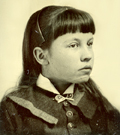 |
Bradley, 1882 [first name initial illegible, unidentified]
Grace M. Bradley would be a possibility but the first initial looks like an S,F, or L
|
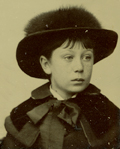 |
Elizabeth (Bessie) Moorfield Storey, 1882
1871 - 1951; married, 1895, Robert Williamson Lovett; parents: Moorfield Storey and Ann Gertrude Cutts; lived at 44 Edge Hill Road, in a house that still stands. . The family house at 44 Edgehill Road was designed by Robert Peabody, a well-known architect who had been her fatherís college roommate and lived next door. Moorfield Storey was a president of the American Bar Association and the president for most of its existence of the Anti-Imperialist League, an organization founded to oppose the annexation of the Philippines as a colony and to support free trade and the gold standard. Its members included Jane Addams, Andrew Carnegie, Grover Cleveland,
Mark Twain, Samuel Gompers, and John Dewey, among many notables. Later, Storey became the first president of the NAACP, a role he served in from 1910 until his death in 1929.
Elizabeth led a womenís organization in support of French recovery after World War I, an effort that earned her induction into the French Legion of Honor. She aided that country again after World War II. (The Boston Globe, covering a 1947 visit to Normandy, described her as "a regal-appearing great-grandmother, whose fragile exterior appears in great contradiction to her drive, energy, and organizing talent".) She was also a leader in the effort to repeal Prohibition and active in many other civic organizations. Her husband, who died in 1924, was a prominent orthopedic surgeon. They purchased 7 Fairfield St., Boston in 1901 and lived there until his death.
|
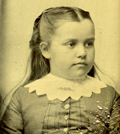 |
Elizabeth (Bessie) Lowell Everett, 1882 [identity speculative]
1870-1951; never married; parents: Percival Lowell Everett and Elizabeth Davis Williams Weld.
Her father was the founder and president of the Third National Bank of Boston. Her mother died in 1875. In 1882, her father married Elizabeth Russell Fisher of Brookline whose family lived on Heath Street at the corner of Boylston Street. Elizabeth later lived in Lynn, but moved to Brookline after her fatherís death in 1908. She lived in Concord from 1914 to the end of her life with Mary A. Barrett, a former nurse with whom Elizabeth had worked at a boarding house run by the Boston YWCA. Elizabeth was on the staff of the Boston Athenaeum as a young woman and later became a writer and lecturer on U.S. and local history. During World War I she served on the State Commission for the Blind and helped in relief efforts after the Halifax Explosion in 1917 in which many people were blinded.
|
|